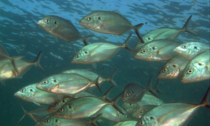
The federal government will spend $20m to buy out fisheries in Australia’s south-east in part because the climate crisis is affecting population numbers of some species, making current fishing levels unsustainable. The Australian Fisheries Management Authority will buy back vessel permits in the south-east trawl fishery, which is the largest commonwealth-managed fin fish fishery in Australia.
It is the first time the authority has said it will conduct a buyout because of climate change and environmental factors, which are preventing the recovery of some populations.
The government announced $24m in the March budget for a structural adjustment package for the fishery, the bulk of which is for the buyouts to try to ensure its long-term sustainability.
The authority told a Senate hearing in April that it was particularly concerned about population numbers of four species – jackass morwong, redfish, john dory and silver trevally – whose numbers did not appear to be recovering despite being subject to low catch limits designed to address historic overfishing.
The authority’s chief executive, Wez Norris, told the hearing that the large-scale closure of some operators was necessary, describing the magnitude of this step as “quite shocking”.
The Greens healthy oceans spokesperson, Peter Whish-Wilson, said it marked “the first time we’re having a discussion about the impacts of climate change on fisheries and ultimately on exports and fishing communities”.
“I think it’s long overdue because the climate impacts have been there for some time and there’s been a failure to acknowledge that in any formal sense,” he said. “To see a fishery essentially shut down over climate change, it’s a worrying precedent.”
In the previous parliament, a Senate inquiry had been examining the management of quotas in Australia’s fishing industry.
Whish-Wilson said he hoped the inquiry would continue in the next parliament and that it would explore both the planned buyouts in the south-east as well as any climate impacts that had already been quantified in Australia’s fisheries more broadly.
A spokesperson for the authority said the 57 permits in the south-east trawl fishery were all eligible for buyout and the process for that was being determined.
The spokesperson said the eastern Australian current had been warming, extending further down the coast and persisting for longer, which had caused some subtropical species to extend their range farther south but also pushed the northern range of some cold-water species southwards.
Very low catch limits for species such as redfish had been aimed at enabling stocks to rebuild but these “do not appear to be recovering as anticipated”.
The population of jackass morwong had also shown accelerated declines even though catch limits had been lowered.
“It is now clear that limiting the catch of some species has not enabled them to rebuild or is not slowing their rate of decline … and that other factors [such as climate change] are impacting fish stocks within the south-east trawl fishery,” the spokesperson said.
The Australian Marine Conservation Society expressed concern that management practices within the fishery were also a factor, alongside climate change, in the decline of some fish species.
The AMCS’s sustainable seafood program manager, Adrian Meder, said the south-east trawl fishery was one that had benefited from an earlier buyout in 2005-06 aimed at addressing declining populations.
He said since that time measures that would have improved scrutiny and detected overfishing – such as cameras on boats – had still not been introduced in the fishery.
“Taxpayers might feel better about another big payout for this fishery if that concrete action had been taken already,” Meder said. “Any payout now must come with immediate and effective reform of the fishery and how it operates in a rapidly changing climate.”
The South East Trawl Fishing Association said the 2005 reforms had moved the fishery “into a situation where no fish stock has been experiencing overfishing since”.
The association’s executive officer, Simon Boag, said despite this there had not been an average jackass morwong recruitment (the arrival of baby fish into the fishery) in more than a decade.
He said the buyout was a “tough move” but rebuilding fish populations would require fewer vessels in the fishery.
“The only thing we can control is how much fish we take, in this case the current adjustment does just that – it will significantly lower the catch of jackass morwong,” he said.
The authority’s spokesperson said all commonwealth fisheries, including the south-east trawl fishery, were managed in accordance with the government’s harvest policy, which ensured catch limits were set in line with scientific advice.
“Application of the harvest strategy policy has provided transparent, reliable and consistent decision making, providing high levels of confidence that fishing has been occurring at sustainable levels,” the spokesperson said.












Social Profiles